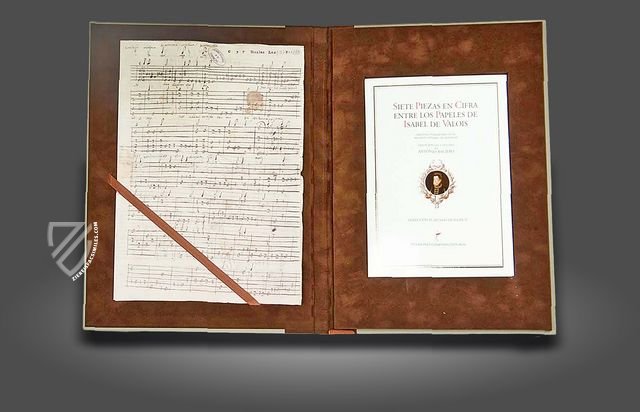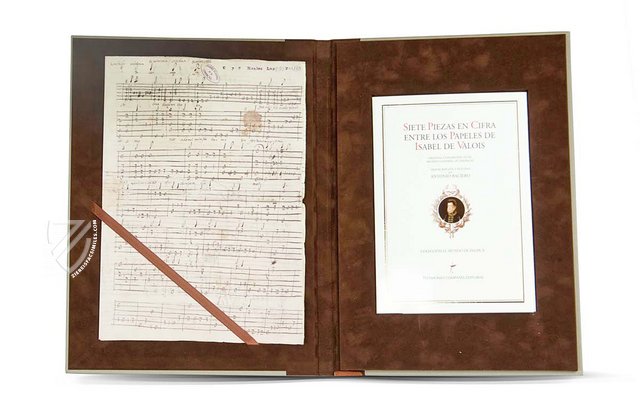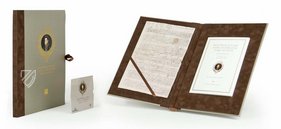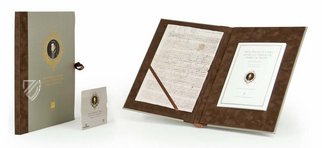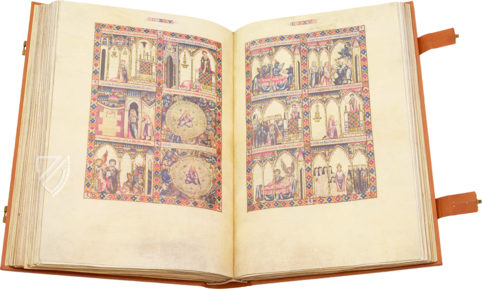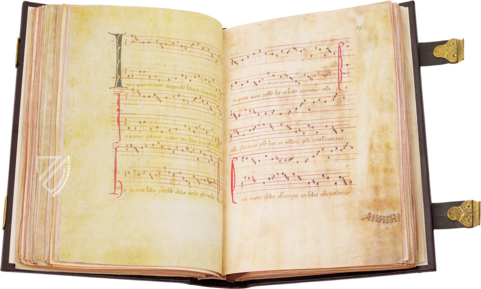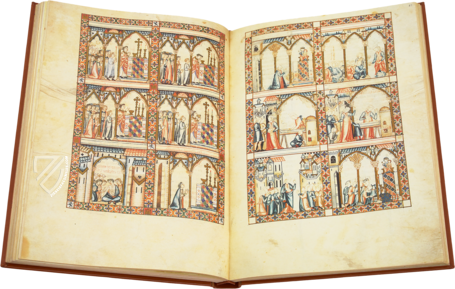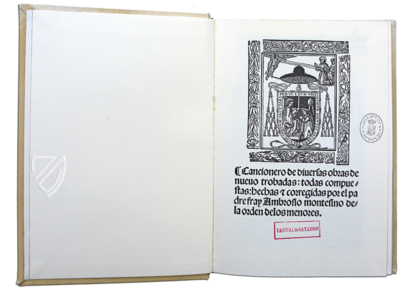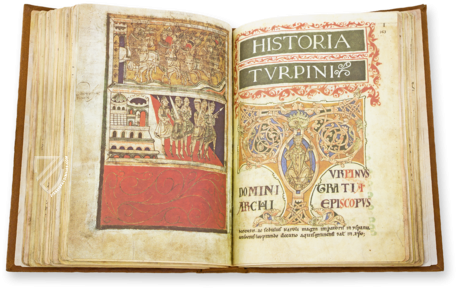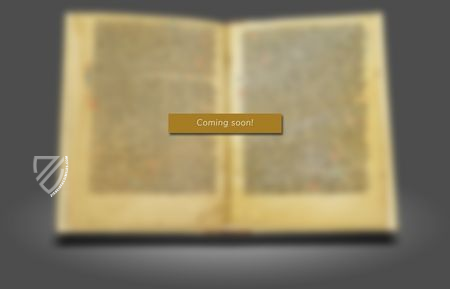Seven musical scores belonging to Isabelle de Valois
(under 1,000€)
A true treasure of music history is stored in the Archivo General in Simancas, Spain: a 16th century manuscript with six pieces for the vihuela. This Spanish string instrument is similar to a lute and was particularly popular in the 15th and 16th centuries and its use was widespread in Spain. The so-called Simancas Manuscript was recently discovered in a diverse compendium of documents from the personal collection of the Spanish Queen Isabell de Valois. The two leaves with the songs, together with an additional 19th century document, are one of only two surviving pieces of evidence of vihuela music in manuscript form that survive today!
Seven Musical Scores Belonging to Isabelle de Valois
A true treasure of music history is stored in the Archivo General in Simancas, Spain: a 16th century manuscript with six pieces for the vihuela. This Spanish string instrument is similar to a lute and was particularly popular in the 15th and 16th centuries and its use was widespread in Spain. The so-called Simancas Manuscript was recently discovered in a diverse compendium of documents from the personal collection of the Spanish Queen Isabell de Valois. The two leaves with the songs, together with an additional 19th century document, are one of only two surviving pieces of evidence of vihuela music in manuscript form that survive today!
Harmonious Melodies Composed in the 16th Century
Rivera verde umbrosa, Por unos ojuelos negros und Falsa me es la espiga de zuela: that is the enthusiastic title of a few compositions, which contain a valuable document for music history with the signature Casa y Sitios Reales, Legajo 394, folio 130 of the General Archive in Simancas. Six pieces of music are written down on three sheets, three of the songs have lyrics. Additionally, one finds the pieces Contrapunto sobre el Conde Claros, Pavanilla, and Diferencias sobre "Guárdame las vacas".
A Spanish String Instrument
These six compositions for the vihuela originate from an anonymous composer and are one of very few specimens of evidence in manuscript form regarding the music of this instrument. The so-called Simancas Manuscript was only recently rediscovered. Only two manuscripts with compositions for the vihuela survive today, besides most of these have only been transmitted in print form. The vihuela is a Spanish plucking instrument with 6–7- strings. It is comparable to a lute and can be seen as a counterpart to the Italian and Portuguese viola. The vihuela was most popular in the 15th and 16th centuries, whereby the 16th century represented the highpoint of their prevalence in Spain.
In the Possession of the Spanish Queen?
Altogether, the Simancas Manuscript consists of 6 pages. A double page with three written sides and a blank page with the musical scores. Furthermore, they are accompanied by an additional document with annotations from the 19th century. It was found in a loose compendium of documents from the years 1628–1633, which probably originated from the private collection of the Spanish Queen Isabell de Valois. Isabell de Valois (1545–1568) was the daughter of the French King Henry II and was married to King Philip II of Spain. As the third wife of Philip II, she was not only a French princess but also a Spanish Queen. The Simancas Manuscript with its six compositions for the vihuela is a unique document of music history and an impressive testimonial to 16th century Spanish music!
Codicology
- Alternative Titles
- Siete piezas en cifra entre los papeles de Isabel de Valois
Sieben Partituren von Isabelle de Valois - Type
- Manuscript on paper
- Size / Format
- 6 pages / 31.0 × 21.8 cm
- Origin
- Spain
- Date
- 16th century
- Epochs
- Style
- Genre
- Previous Owners
- Isabelle de Valois
#1 Siete piezas en cifra entre los papeles de Isabel de Valois
Language: Spanish
(under 1,000€)
- Treatises / Secular Books
- Apocalypses / Beatus
- Astronomy / Astrology
- Bestiaries
- Bibles / Gospels
- Chronicles / History / Law
- Geography / Maps
- Saints' Lives
- Islam / Oriental
- Judaism / Hebrew
- Single Leaf Collections
- Leonardo da Vinci
- Literature / Poetry
- Liturgical Manuscripts
- Medicine / Botany / Alchemy
- Music
- Mythology / Prophecies
- Psalters
- Other Religious Books
- Games / Hunting
- Private Devotion Books
- Other Genres
- Afghanistan
- Armenia
- Austria
- Belgium
- Colombia
- Croatia
- Czech Republic
- Denmark
- Egypt
- Ethiopia
- France
- Germany
- Hungary
- India
- Iran
- Iraq
- Israel
- Italy
- Japan
- Luxembourg
- Mexico
- Morocco
- Netherlands
- Peru
- Poland
- Portugal
- Russia
- Serbia
- Spain
- Sri Lanka
- Sweden
- Switzerland
- Syria
- Turkey
- Ukraine
- United Kingdom
- United States
- Uzbekistan
- Aboca Museum
- Ajuntament de Valencia
- Akademie Verlag
- Akademische Druck- u. Verlagsanstalt (ADEVA)
- Aldo Ausilio Editore - Bottega d’Erasmo
- Alecto Historical Editions
- Alkuin Verlag
- Almqvist & Wiksell
- Amilcare Pizzi
- Andreas & Andreas Verlagsbuchhandlung
- Archiv Verlag
- Archivi Edizioni
- Arnold Verlag
- ARS
- Ars Magna
- ArtCodex
- AyN Ediciones
- Azimuth Editions
- Badenia Verlag
- Bärenreiter-Verlag
- Belser Verlag
- Belser Verlag / WK Wertkontor
- Benziger Verlag
- Bernardinum Wydawnictwo
- BiblioGemma
- Biblioteca Apostolica Vaticana (Vaticanstadt, Vaticanstadt)
- Bibliotheca Palatina Faksimile Verlag
- Bibliotheca Rara
- Boydell & Brewer
- Bramante Edizioni
- Brepols Publishers
- British Library
- C. Weckesser
- Caixa Catalunya
- Canesi
- CAPSA, Ars Scriptoria
- Caratzas Brothers, Publishers
- Carus Verlag
- Circulo Cientifico
- Club Bibliófilo Versol
- Club du Livre
- CM Editores
- Collegium Graphicum
- Collezione Apocrifa Da Vinci
- Comissão Nacional para as Comemorações dos Descobrimentos Portugueses
- Coron Verlag
- Corvina
- CTHS
- D. S. Brewer
- De Agostini/UTET
- De Schutter
- Deuschle & Stemmle
- Deutscher Verlag für Kunstwissenschaft
- DIAMM
- Droz
- E. Schreiber Graphische Kunstanstalten
- Ediciones Boreal
- Ediciones Grial
- Ediclube
- Edições Inapa
- Edilan
- Editalia
- Edition Georg Popp
- Edition Leipzig
- Edition Libri Illustri
- Editiones Reales Sitios S. L.
- Éditions de l'Oiseau Lyre
- Editions Medicina Rara
- Editorial Casariego
- Editorial Mintzoa
- Editrice Antenore
- Editrice Velar
- Edizioni Edison
- Egeria, S.L.
- Eikon Editores
- Electa
- Enciclopèdia Catalana
- Eos-Verlag
- Ephesus Publishing
- Eugrammia Press
- Extraordinary Editions
- Fackelverlag
- Facsimila Art & Edition
- Facsimile Editions Ltd.
- Facsimilia Art & Edition Ebert KG
- Faksimile Verlag
- Feuermann Verlag
- Folger Shakespeare Library
- Franco Cosimo Panini Editore
- Friedrich Wittig Verlag
- Fundación Hullera Vasco-Leonesa
- G. Braziller
- Gabriele Mazzotta Editore
- Gebr. Mann Verlag
- Gesellschaft für graphische Industrie
- Getty Research Institute
- Giovanni Domenico de Rossi
- Giunti Editore
- Graffiti
- Grafica European Center of Fine Arts
- Guido Pressler
- Guillermo Blazquez
- H. N. Abrams
- Harrassowitz
- Helikon
- Hendrickson Publishers
- Henning Oppermann
- Herder Verlag
- Hes & De Graaf Publishers
- Hoepli
- Hortus Deliciarum
- Houghton Library
- Hugo Schmidt Verlag
- Idion Verlag
- Il Bulino, edizioni d'arte
- ILte
- Imago
- Insel Verlag
- Instituto de Estudios Altoaragoneses
- Instituto Nacional de Antropología e Historia
- Istituto dell'Enciclopedia Italiana - Treccani
- Istituto Ellenico di Studi Bizantini e Postbizantini
- Istituto Geografico De Agostini
- Istituto Poligrafico e Zecca dello Stato
- Italarte Art Establishments
- J. Thorbecke
- Jan Thorbecke Verlag
- Johnson Reprint Corporation
- Jugoslavija
- Karl W. Hiersemann
- Kasper Straube
- Kaydeda Ediciones
- Konrad Kölbl Verlag
- Kurt Wolff Verlag
- La Liberia dello Stato
- La Linea Editrice
- La Meta Editore
- Lambert Schneider
- Landeskreditbank Baden-Württemberg
- Leo S. Olschki
- Les Incunables
- Library of Congress
- Libreria Musicale Italiana
- Lichtdruck
- Lito Immagine Editore
- Lumen Artis
- Lund Humphries
- M. Moleiro Editor
- Maison des Sciences de l'homme et de la société de Poitiers
- Manuscriptum
- Maruzen-Yushodo Co. Ltd.
- MASA
- McGraw-Hill
- Militos
- Millennium Liber
- Müller & Schindler
- National Library of Wales
- Neri Pozza
- Nova Charta
- Oceanum Verlag
- Odeon
- Orbis Mediaevalis
- Orbis Pictus
- Österreichische Staatsdruckerei
- Oxford University Press
- Pageant Books
- Parzellers Buchverlag
- Patrimonio Ediciones
- Pattloch Verlag
- PIAF
- Pieper Verlag
- Plon-Nourrit et cie
- Prestel Verlag
- Princeton University Press
- Prisma Verlag
- Priuli & Verlucca, editori
- Pro Sport Verlag
- Propyläen Verlag
- Pytheas Books
- Quaternio Verlag Luzern
- Reales Sitios
- Recht-Verlag
- Reichert Verlag
- Reichsdruckerei
- Riehn & Reusch
- Roberto Vattori Editore
- Rosenkilde and Bagger
- Roxburghe Club
- Salerno Editrice
- Sarajevo Svjetlost
- Schöck ArtPrint Kft.
- Scolar Press
- Scrinium
- Scripta Maneant
- Scriptorium
- Siloé, arte y bibliofilia
- SISMEL - Edizioni del Galluzzo
- Sociedad Mexicana de Antropología
- Sorli Ediciones
- Stainer and Bell
- Styria Verlag
- Sumptibus Pragopress
- Szegedi Tudomànyegyetem
- Taberna Libraria
- Tarshish Books
- Taschen
- Tempus Libri
- Testimonio Compañía Editorial
- Thames and Hudson
- The Clear Vue Publishing Partnership Limited
- The Facsimile Codex
- The Folio Society
- The Marquess of Normanby
- The Richard III and Yorkist History Trust
- Tip.Le.Co
- TouchArt
- TREC Publishing House
- TRI Publishing Co.
- Trident Editore
- Typis Regiae Officinae Polygraphicae
- Universidad de Granada
- University of California Press
- University of Chicago Press
- Urs Graf
- Vallecchi
- Van Wijnen
- VCH, Acta Humaniora
- VDI Verlag
- Verlag für Regionalgeschichte
- Verlag Styria
- Vicent Garcia Editores
- W. Turnowsky
- Wiener Mechitharisten-Congregation (Wien, Österreich)
- Wissenschaftliche Buchgesellschaft
- Xuntanza Editorial
- Zollikofer AG

